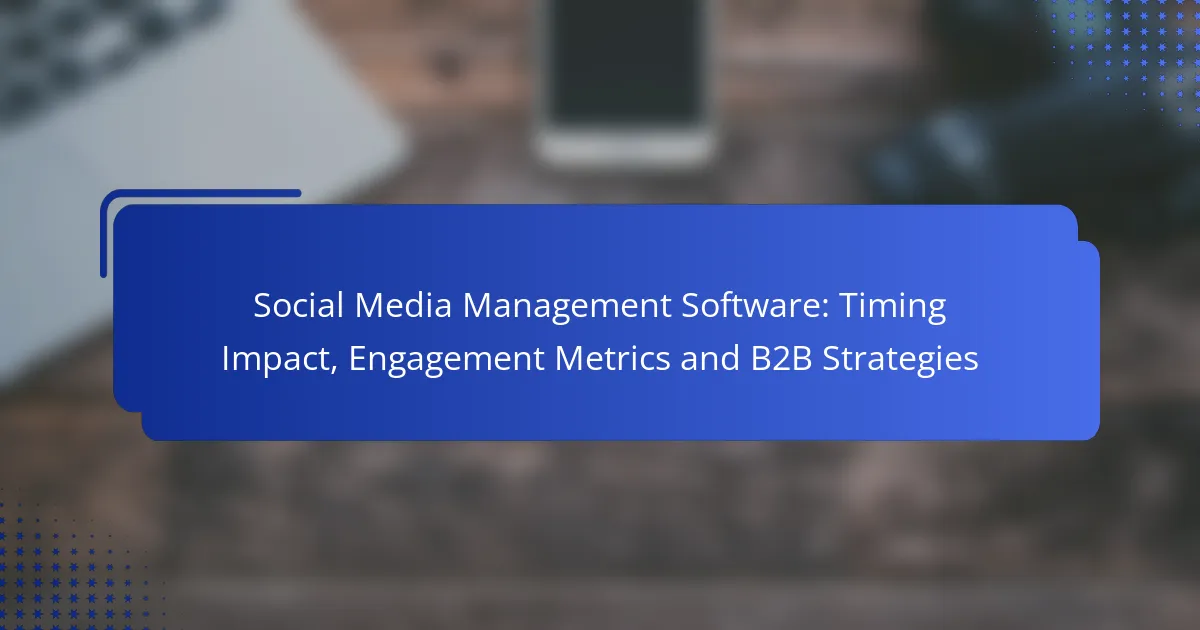Effective social media management is crucial for maximizing engagement and driving results in today’s digital landscape. Timing plays a pivotal role in reaching your audience when they are most active, while key engagement metrics provide insights into content performance. Utilizing specialized tools can further enhance your B2B strategies, enabling businesses to optimize their online presence and analyze engagement effectively.

How does timing impact social media engagement?
Timing significantly influences social media engagement by determining when your audience is most active and receptive to content. Posting at optimal times can enhance visibility, increase interactions, and ultimately drive better results for your campaigns.
Optimal posting times for B2B
For B2B companies, the best times to post are typically during business hours, particularly mid-week. Research suggests that Tuesdays, Wednesdays, and Thursdays between 10 AM and 2 PM often yield the highest engagement rates. Consider scheduling posts around these times to maximize visibility among professional audiences.
Additionally, using analytics tools can help identify specific peak times for your audience. Tailoring your posting schedule based on these insights can lead to more effective engagement strategies.
Influence of time zones on engagement
Time zones play a crucial role in social media engagement, especially for businesses operating in multiple regions. Understanding the time differences can help you schedule posts that reach audiences when they are most likely to be online. For instance, if your target market spans the U.S. and Europe, consider staggered posting times to accommodate both regions.
Utilizing social media management tools that allow for automatic scheduling can simplify this process. This ensures that your content is published at the right times, regardless of your location.
Seasonal trends in social media activity
Seasonal trends can significantly affect social media activity, with engagement often peaking during specific times of the year. For example, the holiday season typically sees increased online activity, making it a prime time for B2B promotions. Conversely, summer months may experience a dip in engagement as many professionals take vacations.
Monitoring these seasonal patterns can help you adjust your content strategy accordingly. Planning campaigns around high-activity periods can enhance your reach and effectiveness, while being mindful of low-activity times can prevent wasted efforts.
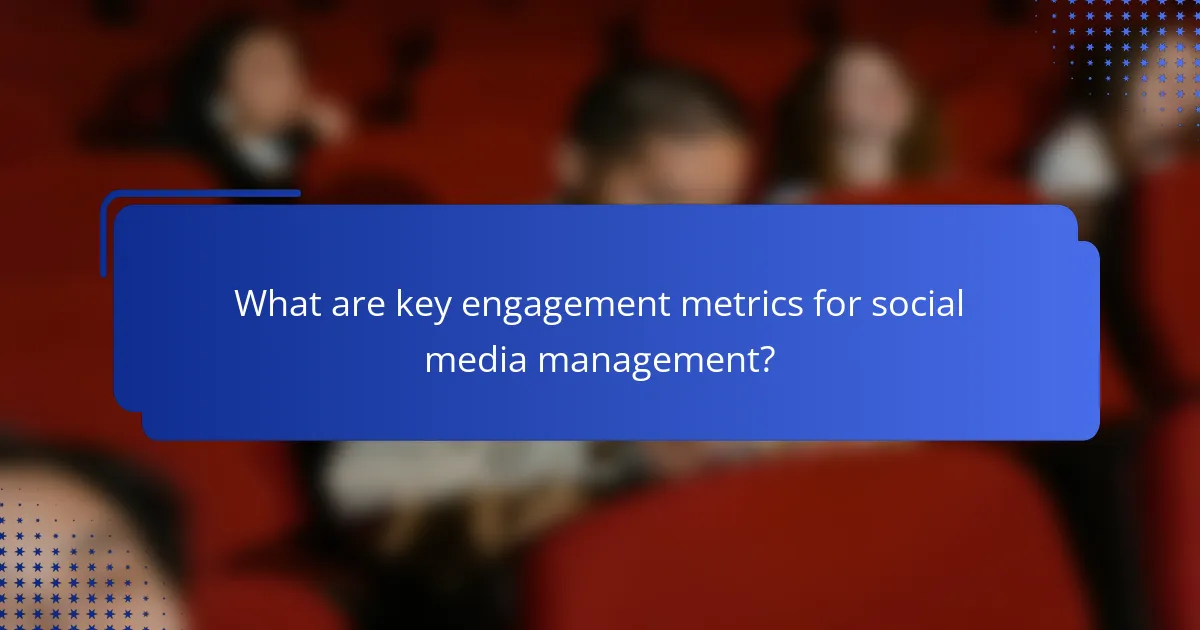
What are key engagement metrics for social media management?
Key engagement metrics for social media management include reach, impressions, engagement rate, and conversion tracking. These metrics help businesses understand how their content performs and how effectively it engages their audience.
Understanding reach and impressions
Reach refers to the total number of unique users who see your content, while impressions indicate how many times your content is displayed, regardless of whether it was clicked. Understanding these metrics is crucial for assessing the visibility of your posts and the potential audience size.
For example, if a post has a reach of 1,000 but 3,000 impressions, it means that some users saw the content multiple times. Monitoring these figures can help you adjust your content strategy to maximize visibility and engagement.
Engagement rate calculations
The engagement rate is a key metric that measures the level of interaction your content receives relative to its reach or impressions. It is typically calculated by dividing the total engagements (likes, shares, comments) by the total reach or impressions, then multiplying by 100 to get a percentage.
A common benchmark for engagement rates on social media is around 1-5%, depending on the platform and industry. Regularly calculating this metric allows you to identify which types of content resonate best with your audience and refine your strategy accordingly.
Conversion tracking for B2B campaigns
Conversion tracking is essential for B2B campaigns as it measures how well your social media efforts lead to desired actions, such as lead generation or sales. This can be done by setting up tracking pixels or using UTM parameters to monitor traffic from social media to your website.
For effective conversion tracking, ensure that you define clear goals, such as form submissions or demo requests, and regularly analyze the data to understand which platforms and content types yield the highest conversion rates. This insight helps you allocate resources more effectively and optimize your campaigns for better results.
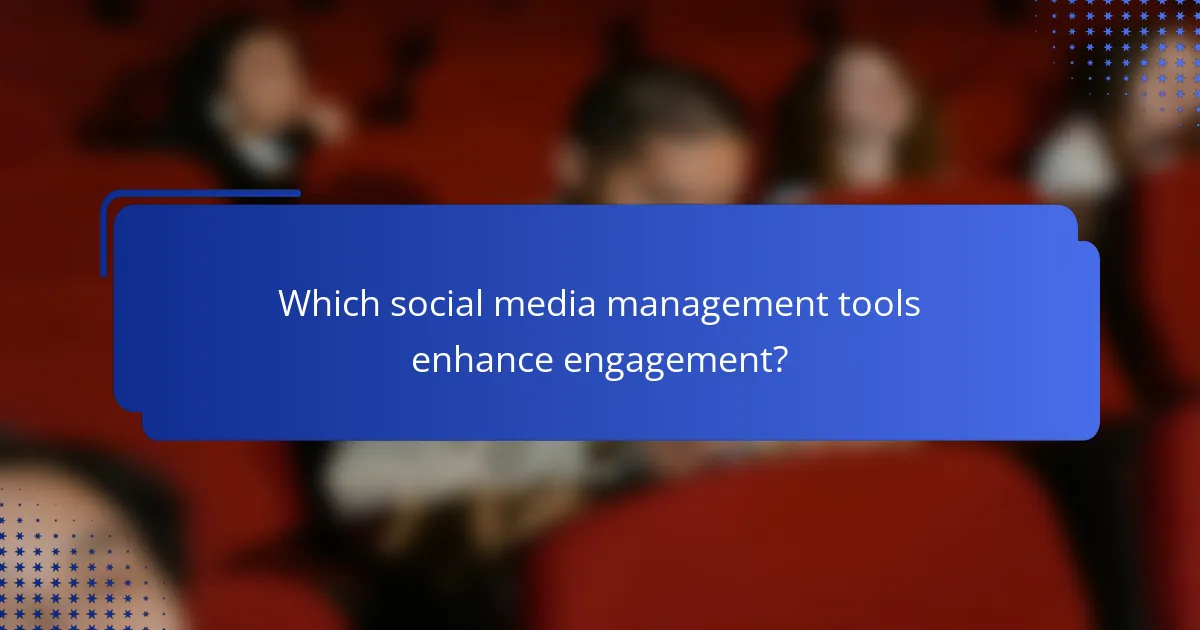
Which social media management tools enhance engagement?
Several social media management tools can significantly enhance engagement by providing features tailored for audience interaction and content optimization. Tools like Hootsuite, Buffer, and Sprout Social offer unique functionalities that cater to B2B strategies, allowing businesses to effectively manage their online presence and analyze performance metrics.
Hootsuite features for B2B
Hootsuite is designed to streamline social media management for B2B companies by offering comprehensive scheduling, monitoring, and reporting features. Its ability to manage multiple accounts from a single dashboard allows businesses to maintain consistent messaging across platforms.
Key features include customizable streams that track mentions, keywords, and competitors, which help businesses stay engaged with their audience. Additionally, Hootsuite’s analytics provide insights into post-performance, enabling companies to refine their strategies based on real-time data.
Buffer’s scheduling capabilities
Buffer excels in scheduling posts efficiently across various social media platforms, making it a valuable tool for B2B engagement. Users can plan their content calendar in advance, ensuring a steady flow of posts that align with peak engagement times for their target audience.
Buffer’s user-friendly interface allows for easy adjustments to posting times and content, which can enhance visibility and interaction. The tool also offers a feature to analyze the best times to post based on audience activity, helping businesses optimize their engagement strategies.
Sprout Social analytics tools
Sprout Social provides robust analytics tools that are essential for B2B companies looking to measure engagement effectively. Its reporting features allow users to track key metrics such as engagement rates, audience growth, and content performance over time.
By utilizing Sprout Social’s insights, businesses can identify trends and adjust their content strategies accordingly. The platform also offers competitive analysis, enabling companies to benchmark their performance against industry standards and refine their engagement tactics for better results.
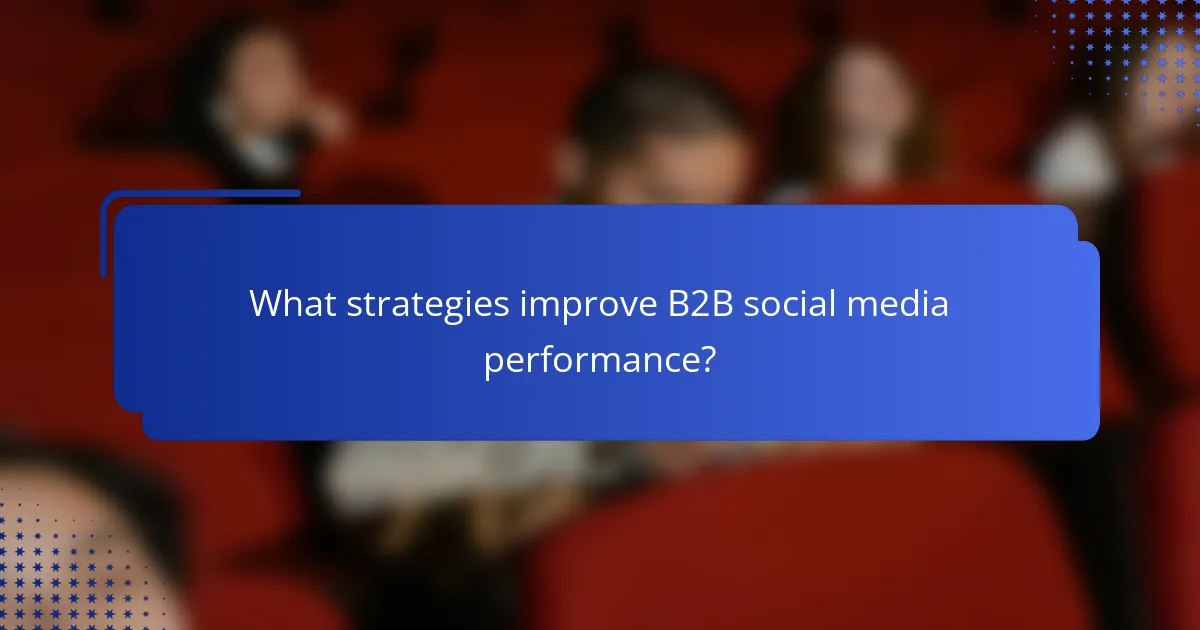
What strategies improve B2B social media performance?
Effective B2B social media performance hinges on strategic alignment of content marketing, precise audience segmentation, and the smart use of paid advertising. Implementing these strategies can significantly enhance engagement and conversion rates.
Content marketing alignment
Aligning content marketing with social media efforts ensures that messaging is consistent and resonates with the target audience. This involves creating valuable, relevant content that addresses the specific needs and pain points of potential clients.
For example, if your audience is primarily interested in industry insights, sharing whitepapers or case studies on social media can drive engagement. Regularly updating content to reflect current trends can also keep your brand relevant and authoritative.
Audience segmentation techniques
Effective audience segmentation allows B2B marketers to tailor their social media strategies to different groups within their target market. By analyzing demographics, interests, and behaviors, businesses can create personalized content that speaks directly to each segment.
Utilizing tools like LinkedIn’s targeting options can help identify key segments, such as decision-makers in specific industries. This targeted approach can lead to higher engagement rates and improved ROI on social media campaigns.
Utilizing paid advertising effectively
Paid advertising on social media platforms can amplify reach and engagement when executed correctly. B2B companies should consider using targeted ads to promote high-value content, such as webinars or product demos, to specific audience segments.
Setting clear objectives for each campaign, such as lead generation or brand awareness, is crucial. Monitoring performance metrics and adjusting strategies based on data can optimize ad spend and improve overall effectiveness. Aim for a balanced budget that allows for experimentation while focusing on high-performing ads.
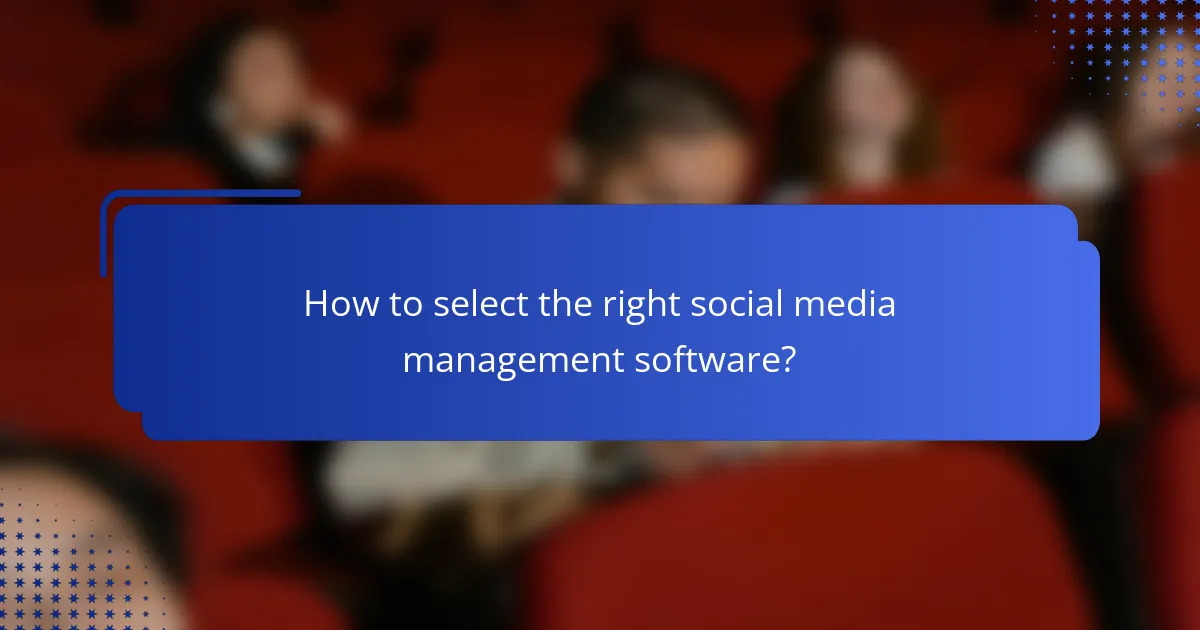
How to select the right social media management software?
Selecting the right social media management software involves understanding your specific needs and evaluating platforms based on key features. Focus on usability, integration capabilities, and analytics to ensure the software aligns with your business goals.
Criteria for evaluating software
When evaluating social media management software, consider user-friendliness, pricing, and customer support. Look for platforms that offer a free trial or demo to test their features before committing. Additionally, assess the software’s ability to integrate with other tools you use, such as CRM systems or email marketing services.
Another important criterion is the analytics and reporting capabilities. Effective software should provide insights into engagement metrics, audience demographics, and post-performance, enabling you to refine your strategy over time. Prioritize tools that offer customizable reports to meet your specific needs.
Comparative analysis of top platforms
Popular social media management platforms include Hootsuite, Buffer, and Sprout Social. Hootsuite is known for its comprehensive features, including scheduling, monitoring, and analytics, making it suitable for larger teams. Buffer, on the other hand, is praised for its simplicity and affordability, ideal for small businesses or individuals.
Sprout Social offers robust reporting and customer engagement tools, which can be beneficial for B2B companies looking to enhance their outreach. Each platform has different pricing tiers, typically ranging from $15 to $200 per month, depending on the features and number of users. Consider your budget and the specific functionalities you need when making a choice.
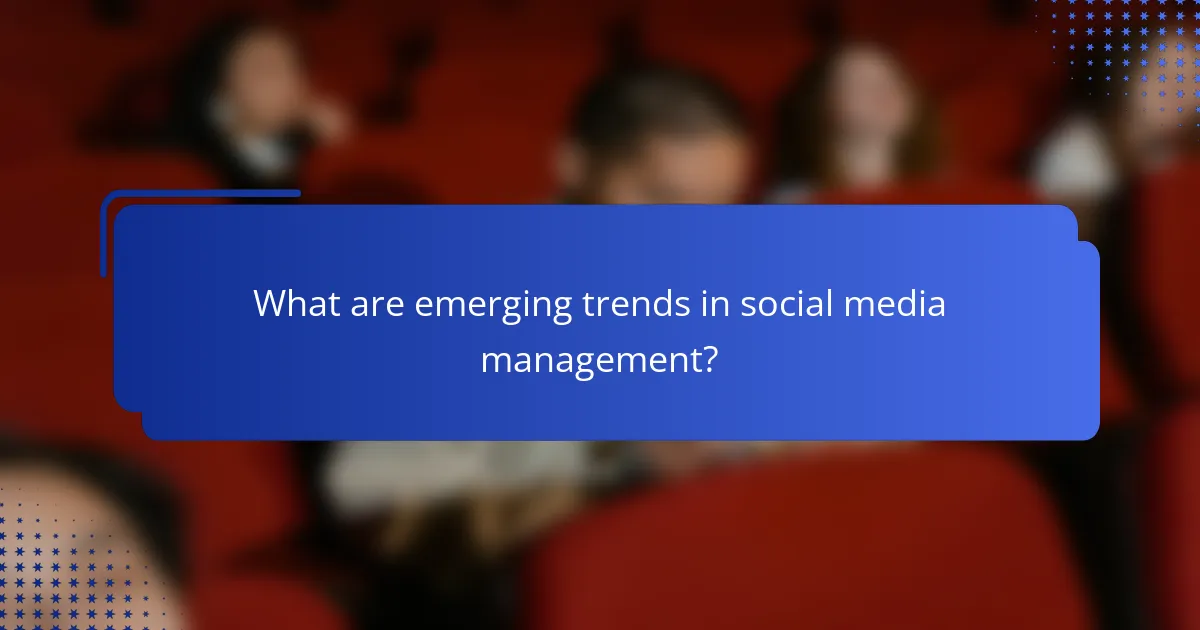
What are emerging trends in social media management?
Emerging trends in social media management focus on leveraging advanced technologies and integrations to enhance user engagement and streamline processes. Key developments include the use of AI-driven analytics tools and the integration of social media platforms with Customer Relationship Management (CRM) systems.
AI-driven analytics tools
AI-driven analytics tools analyze vast amounts of social media data to provide insights into user behavior and engagement patterns. These tools can identify trends, predict outcomes, and suggest optimal posting times, significantly improving content strategy.
For example, platforms like Sprout Social and Hootsuite utilize AI to analyze audience interactions, helping businesses tailor their content to specific demographics. This can lead to higher engagement rates and more effective marketing campaigns.
Integration with CRM systems
Integrating social media management with CRM systems allows businesses to track customer interactions across multiple channels. This integration provides a comprehensive view of customer behavior, enabling more personalized marketing efforts and improved customer service.
For instance, tools like Salesforce and HubSpot offer features that link social media activity with customer profiles, allowing businesses to respond more effectively to inquiries and engage with potential leads. This can enhance customer satisfaction and drive sales conversions.
